Exploring Public Opinions on Renewable Energy by Using Conventional Methods and Social Media Analysis
Abstract
:1. Introduction
2. Public Opinion about RESs in Hungary
2.1. Measures of Opinions on RES
2.2. Measures of Opinions on the Environment
2.3. Measure of the Worry about the Use of Nuclear Energy
2.4. Measures of Opinion on Living Standard and Life Satisfaction
3. Social Media Analysis Based on the Smap Works Big Data Ecosystem
- Find data source and integrate data to own database:
- ○
- Direct social media API access (Facebook, Twitter, TikTok, etc.);
- ○
- Content provider who collects data from various sources (datastreamer, marketwatch, etc.);
- ○
- Web crawling from related sources (blogs, forums, news sites and comments, etc.).
- Extract quantitative data from text:
- ○
- Standard information collected by data provider as date, gender, geotag, age, etc.,
- ○
- Free text statistics collecting numbers and summarizing words for word cloud visualization.
- Sentiment analysis with a standardized method;
- Visualization.
3.1. Solar Market Analysis
- Absorbent Glass Mat (AGM);
- Aqueous Hybrid Ion, AHI—salt water;
- Lithium-Ion, Li-ion (lithium manganese oxide, nickel-cobalt manganese or lithium-nickel-manganese-cobalt oxide);
- Lithium-Iron-Phosphate, LiFePO4;
- Olivine-type-Lithium-Iron-Phosphate, Olivine-type-LiFePO4;
- Vented lead-acid battery, OPzS;
- Sealed lead-acid battery, OPzV.
3.2. Possible Method of Social Media Analysis Based on Target Groups
3.3. Standard Social Media Monitoring Proposal in the RES Topic
- Data source and integration:
- Data source is individual, based on topic behalf of RESs:
- Wide sources of news portals, blogs, Twitter, Facebook; accessed with term filtered query;
- Target groups of specific topics from Facebook and/or with Twitter hashtag.
- Google Trends can be used to help identify terms for data query;
- Collection of data serialized, possibly json (can be automatized);
- Migrate data into ElasticSearch database.
- Quantify data:
- Summarization of tags is provided in ElasticSearch;
- Word count, based on using include-and exclude dictionary.
- Sentiment analysis:
- Using NLTK as a widely accepted NLP tool with support of over 50 languages to extract sentiment score.
- Visualization:
- Visualization based on OpenDistro, a free front-end for ElasticSearch.
4. Conclusions
Author Contributions
Funding
Institutional Review Board Statement
Informed Consent Statement
Data Availability Statement
Conflicts of Interest
References
- Available online: https://ec.europa.eu/eurostat/tgm/table.do?tab=table&init=1&language=de&pcode=t2020_31&plugin=1 (accessed on 11 May 2020).
- Bouzarovski, S.; Herrero, S. The energy divide: Integrating energy transitions, regional in equalities and poverty trends in the European Union. Eur. Urban Reg. Stud. 2017, 24, 69–86. [Google Scholar] [CrossRef] [PubMed] [Green Version]
- Li, R.; Crowe, J.; Leifer, D.; Zou, L.; Schoof, J. Beyond big data: Social media challenges and opportunities for understanding social perception of energy. Energy Res. Soc. Sci. 2019, 56, 1–14. [Google Scholar] [CrossRef]
- Pacesila, M.; Burcea, S.; Colesca, S.E. Analysis of renewable energies in European Union. Renew. Sustain. Energy Rev. 2016, 56, 156–170. [Google Scholar] [CrossRef]
- Čábelková, I.; Strielkowski, W.; Firsova, I.; Korovushkina, M. Public Acceptance of Renewable Energy Sources: A Case Study from the Czech Republic. Energies 2020, 13, 1742. [Google Scholar] [CrossRef] [Green Version]
- Heras-Saizarbitoria, I.; Cilleruelo, E.; Zamanillo, I. Public acceptance of renewables and the media: Ananalysis of the Spanish PV solar experience. Renew. Sustain. Energy Rev. 2011, 15, 4685–4696. [Google Scholar] [CrossRef]
- Szabo, L.; Bartek-Lesi, M.; Diallo, A.; Kerekes, L. Nemzeti Energiastrategia Ertekelese REKK Study. Available online: https://rekk.hu/downloads/academic_publications/rekk_policybrief_hu_2020_02.pdf (accessed on 11 May 2021).
- Ribeiro, F.; Ferreira, P.; Araújo, M.; Braga, A. Public opinion on renewable energy technologies in Portugal. Energy 2014, 69, 39–50. [Google Scholar] [CrossRef]
- Zoellner, J.; Schweizer-Ries, P.; Wemheuer, C. Public acceptance of renewable energies: Results from case studies in Germany. Energy Policy 2008, 36, 4136–4141. [Google Scholar] [CrossRef]
- Hondo, H.; Baba, K. Socio-psychological impacts of the introduction of energy technologies: Change in environmental behavior of housholds with photovoltaic systems. Appl. Energy 2010, 87, 229–235. [Google Scholar] [CrossRef]
- Kim, Y.; Kim, M.; Kim, W. Effect of the Fukushima nuclear disaster on global public acceptance of nuclear energy. Energy Policy 2013, 61, 822–828. [Google Scholar] [CrossRef]
- Jain, A.; Jain, V. Sentiment classification of twitter data belonging to renewable energy using machine learning. J. Inf. Optim. Sci. 2019, 40, 521–533. [Google Scholar] [CrossRef]
- Reboredo, J.C.; Ugolini, A. The impact of Twitter sentiment on renewable energy stocks. Energy Econ. 2018, 76, 153–169. [Google Scholar] [CrossRef]
- Loureiro, M.L.; Allo, M. Sensing climate change and energy issues: Sentiment and emotion analysis with social media inthe U.K. and Spain. Energy Policy 2020, 143, 111490. [Google Scholar] [CrossRef]
- Mackenzie, W. Inverter MarketShare. 2020. Available online: https://www.woodmac.com/our-expertise/focus/Power--Renewables/inverter-market-share-2020/ (accessed on 11 May 2020).
- Available online: https://www.nltk.org/api/nltk.sentiment.html (accessed on 11 May 2020).
- Available online: https://www.statista.com/statistics/235323/lithium-batteries-top-manufacturers/ (accessed on 11 May 2020).
- Zsiborács, H.; Baranyai, N.; Vincze, A.; Háber, I.; Pintér, G. Economic and Technical Aspects of Flexible Storage Photovoltaic Systems in Europe. Energies 2018, 11, 1445. [Google Scholar] [CrossRef] [Green Version]
- Available online: https://github.com/harismuneer/Ultimate-Facebook-Scraper (accessed on 11 May 2020).
- Available online: https://pypi.org/project/gender-guesser/ (accessed on 11 May 2020).
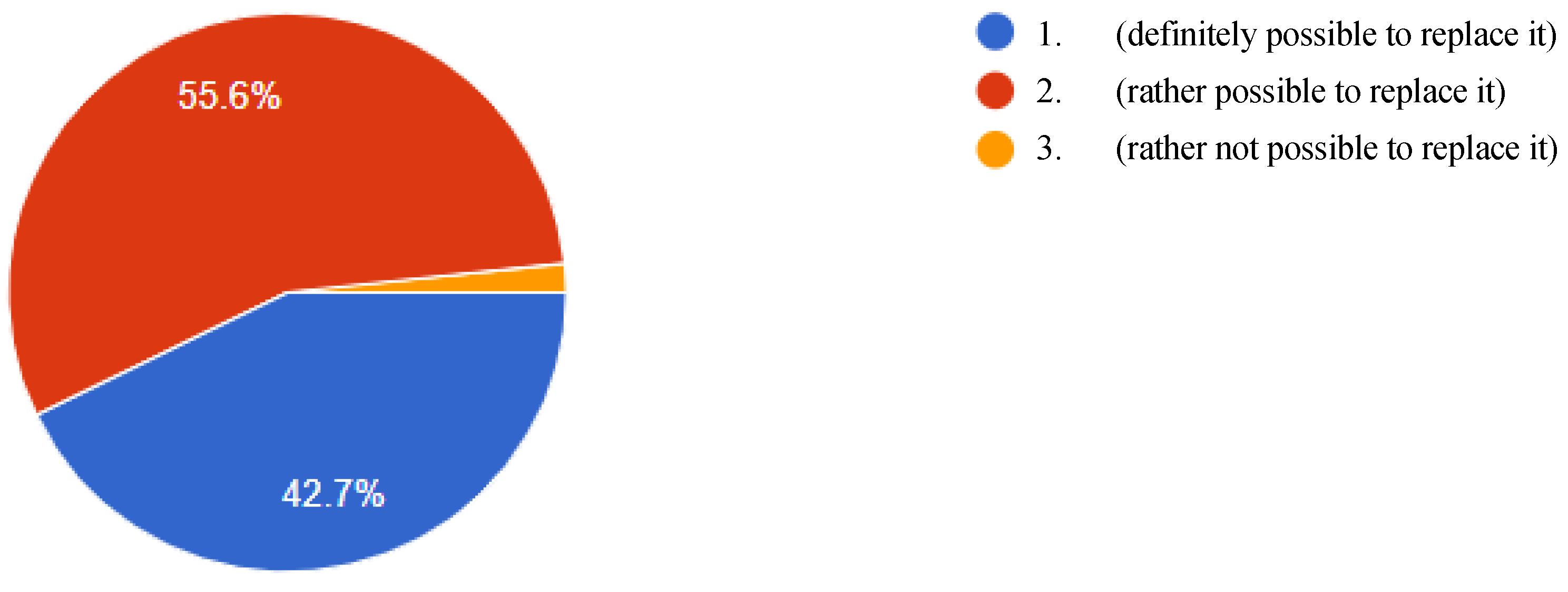
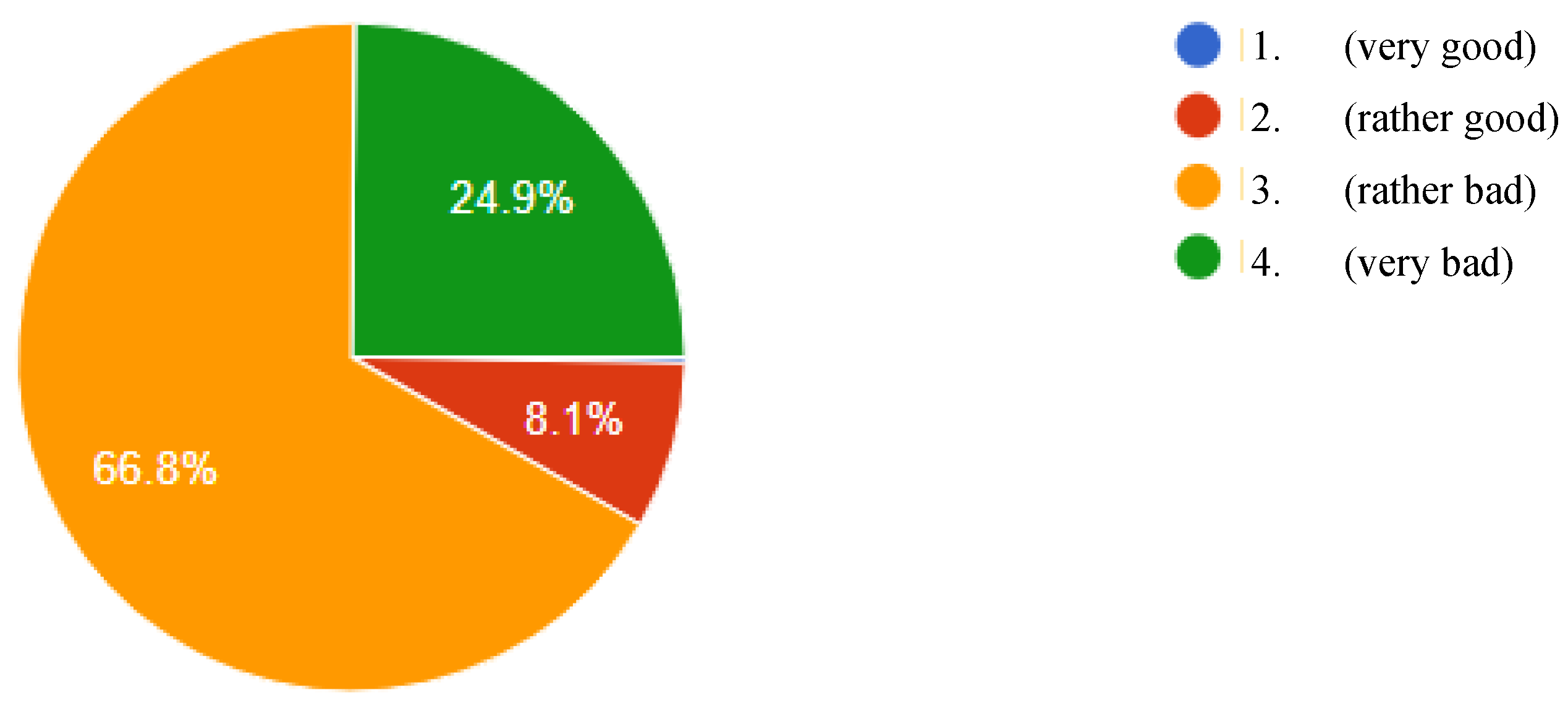
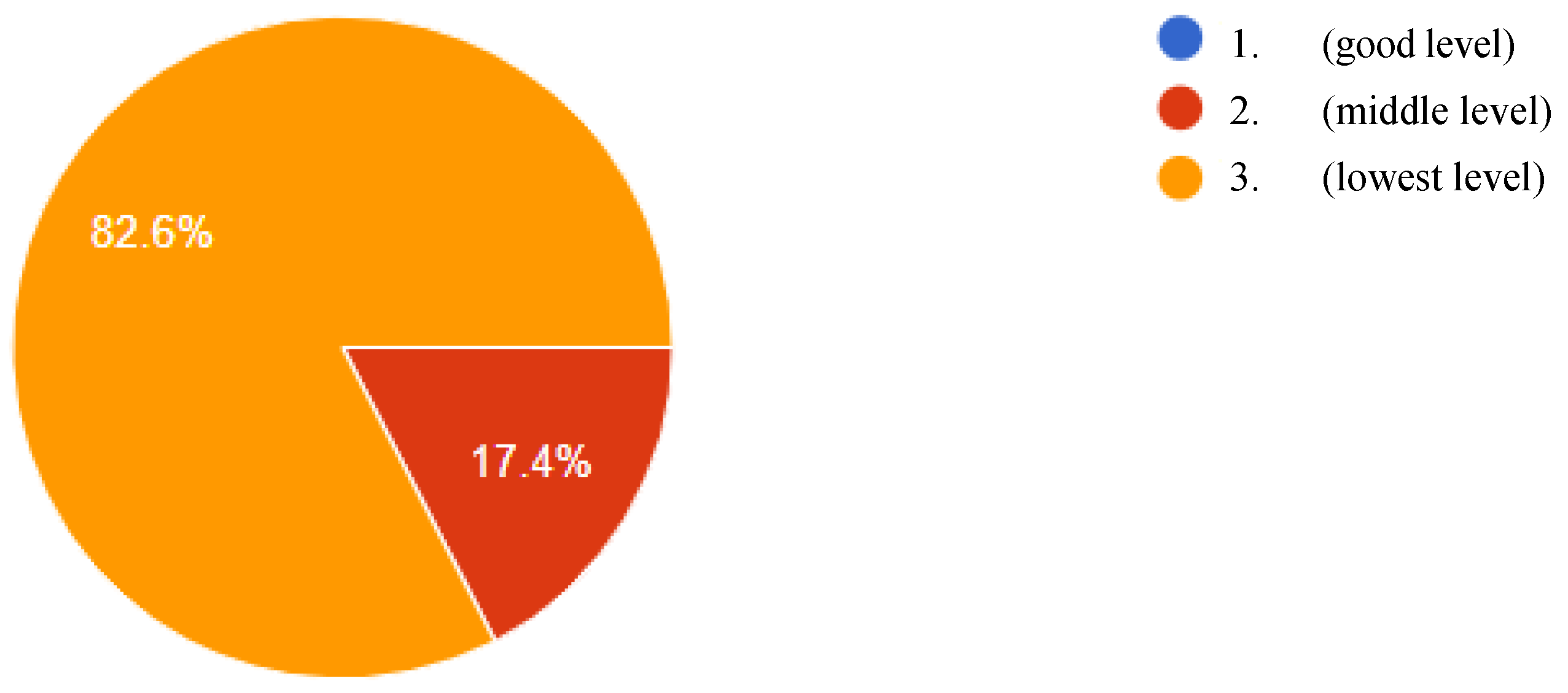


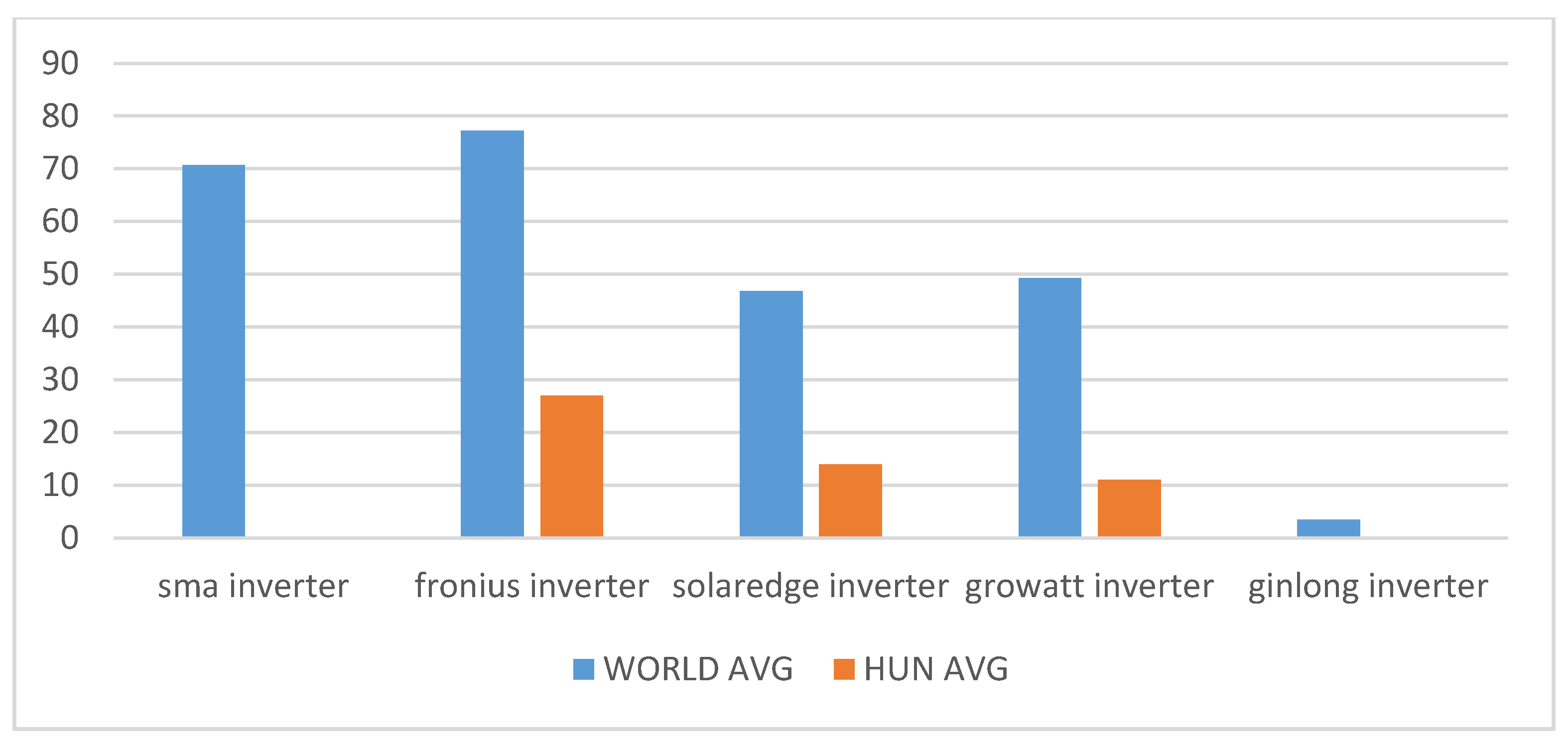

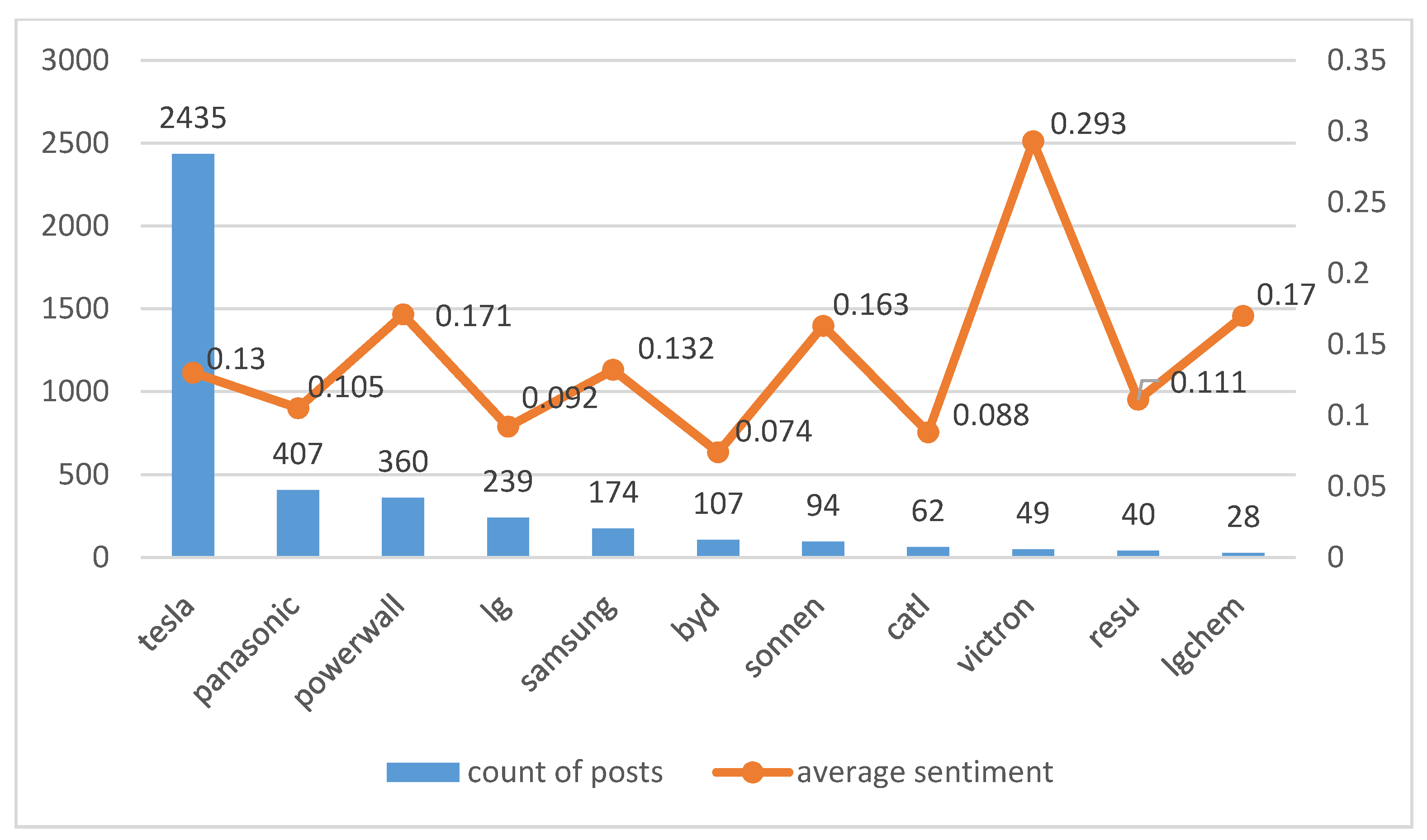
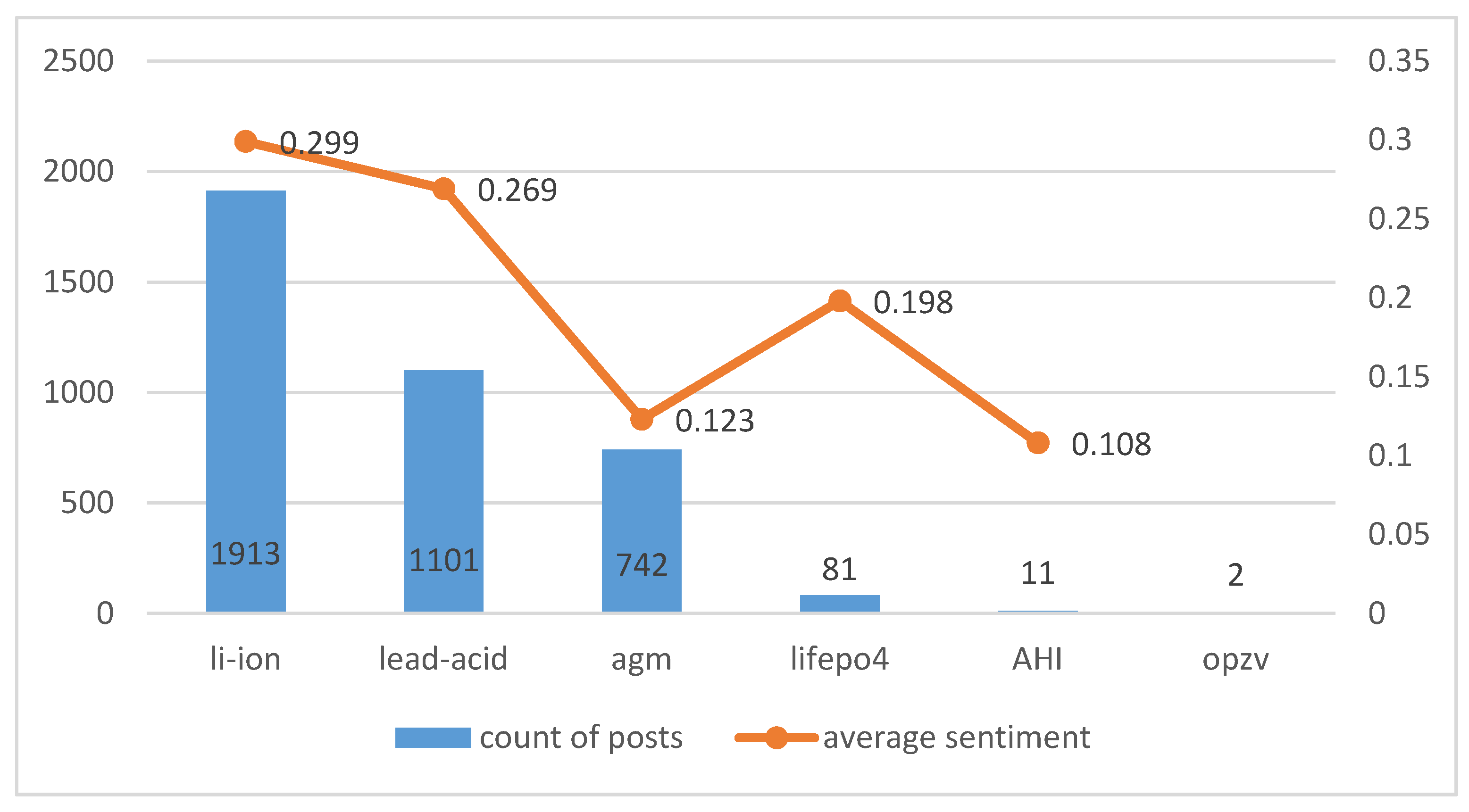


| Answer | Good | Rather Good | Rather Bad | Bad |
|---|---|---|---|---|
| Q4 Hungary | 19.90% | 43.90% | 21.80% | 4.50% |
| Q4 Czech Republic | 19.20% | 42.70% | 24.50% | 12.20% |
| Q5 Hungary | 12.90% | 30.80% | 38.10% | 18.20% |
| Q5 Czech Republic | 2.30% | 35.70% | 45.30% | 10.20% |
| Life Satisfaction and Household Living Standard | |||||
|---|---|---|---|---|---|
| Life satisfaction (Q7):1—very satisfied, 5—very unsatisfied | |||||
| Hungary | 35.5% | 38.5% | 16.8% | 7.3% | 2.0% |
| Czech Republic | 15.8% | 50.8% | 23.6% | 8.4% | 1.3% |
| Household Living Standard (Q8):1—very good, 5—very bad | |||||
| Hungary | 18.8% | 44.0% | 20.8% | 5.1% | 1.4% |
| Czech Republic | 9.4% | 45.6% | 34.0% | 9.5% | 1.3% |
Publisher’s Note: MDPI stays neutral with regard to jurisdictional claims in published maps and institutional affiliations. |
© 2021 by the authors. Licensee MDPI, Basel, Switzerland. This article is an open access article distributed under the terms and conditions of the Creative Commons Attribution (CC BY) license (https://creativecommons.org/licenses/by/4.0/).
Share and Cite
Haber, I.E.; Toth, M.; Hajdu, R.; Haber, K.; Pinter, G. Exploring Public Opinions on Renewable Energy by Using Conventional Methods and Social Media Analysis. Energies 2021, 14, 3089. https://doi.org/10.3390/en14113089
Haber IE, Toth M, Hajdu R, Haber K, Pinter G. Exploring Public Opinions on Renewable Energy by Using Conventional Methods and Social Media Analysis. Energies. 2021; 14(11):3089. https://doi.org/10.3390/en14113089
Chicago/Turabian StyleHaber, Istvan Ervin, Mate Toth, Robert Hajdu, Kinga Haber, and Gabor Pinter. 2021. "Exploring Public Opinions on Renewable Energy by Using Conventional Methods and Social Media Analysis" Energies 14, no. 11: 3089. https://doi.org/10.3390/en14113089






